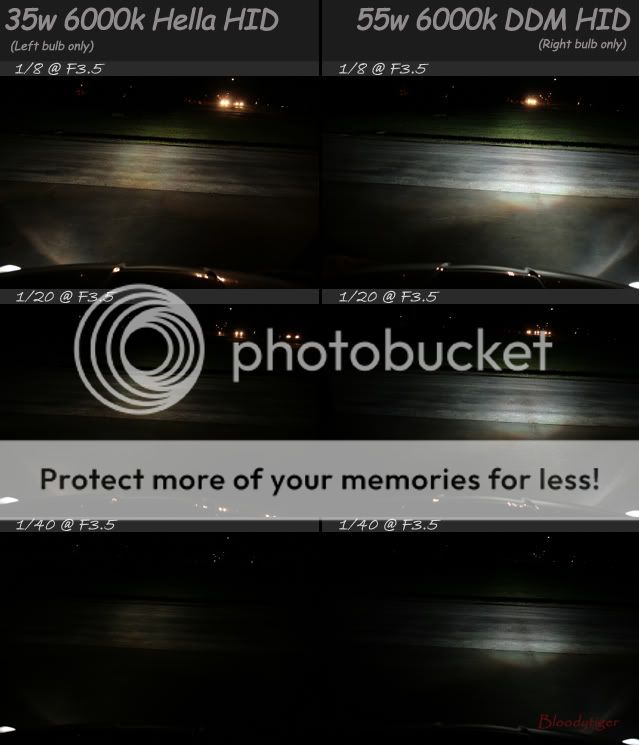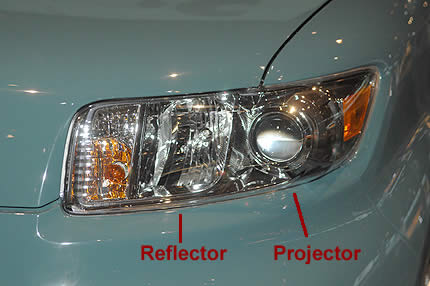My night vision isn't what it used to be, so I decided to give HID lights a try. After all, you can get a conversion kit now for under $25 on Ebay, including shipping. I decided to experiment on our SLK, being its simpler to get at the bulb. I decided to go for a 55w 4300K conversion kit, which provided 3200 lumens vs 1450 lumens of the OEM 55W H7 halogens. This should be great, roughly twice the light!
I installed one bulb so I could do an HID vs halogen comparison. I marked the headlight pattern on the garage wall to make sure before/after alignment had not changed.
The HID was surely a truer white than the yellowish halogen; but to my surprise, it didn't seem much brighter. So, time for a test drive. Once again, the ability to see the lines on the side/middle of the road, especially with the glare of oncoming headlights was only slightly better. However, there was a somewhat wider pattern of illumination from the HIDs, and as noted before, the color more whiter, ie, more "natural."
So, what gives? Time to revert to a little science for a consultation. Clue #1 : human vision, like hearing, is not linear, its logarithmic. So, about twice the lumens yields about a 11% (rough calculation) in perceived brightness. Still being curious, but lacking a light meter, I decided to set my camera at a fixed shutter speed, a fixed ISO, and measure the resulting f/stop. The difference was tiny, measured either at the adjusting points on the headlight lens or at about 3 feet away zooming in on the headlight assembly. OK, there may be a better scientific way to measure the total light output, but the numbers were close enough to agree with the calculation and verified my visual experience.
Looking on Prime, I saw old posts saying a relay should be used for the 12V power when using 55 W HIDs. But, the OEM bulbs are 55W on the NSX (as well as the SLK), and the NSX high beams are 65W. Could the reason be start-up current? The HID kit I bought rates start-up current as less than 10A. This kit uses a digital "ballast" (really a controller and converter to high voltage), so perhaps the older analog HID ballasts drew a higher start-up current. But, what's the start-up current on a halogen bulb? I did a measurement on the H7 filament at room temperature and it was 0.3 Ohms (on a calibrated Fluke DMM). That means a start-up current of 40 amps for the halogen bulb. Even if my measurement was off by 33% at this low resistance, start-up current is still 30 amps. And the lower the ambient temperature (we had 0F here a few days ago), the lower the resistance of the filament, the higher the start-up current of the halogen bulb. But, of course the halogen bulb's filament resistance quickly increases to about 3 Ohms as the filament warms up so the current then is about 4.2 Amps.
My conclusions, based on the specific kit I purchased:
• 55W HIDs don't need a relay if the OEM halogens were 55W, at least for the latest HID technology
• Expect truer color, and perhaps a broader light pattern, but any gain in actual perceived brightness is minimal
• The latest HID bulbs don't affect headlight alignment
• Noise filtering on the digital ballast seems OK. I could not detect any RF interference on the radio or a change in any electronically controlled car operation.
Epilog
Installation was truly plug & play – not much more time involved than replacing the headlight bulb. But, it requires cutting a hole in the dust/moisture cap behind the bulb for the wiring to the ballast. The kit wiring includes a well-sealed grommet on the wiring so the integrity of the cap is not violated. I decided to keep the OEM halogen bulbs and the caps as back-up, and purchase a new/used set of caps for use with the HIDs. The caps will cost me a couple dollars more than the HID kit!
I installed one bulb so I could do an HID vs halogen comparison. I marked the headlight pattern on the garage wall to make sure before/after alignment had not changed.
The HID was surely a truer white than the yellowish halogen; but to my surprise, it didn't seem much brighter. So, time for a test drive. Once again, the ability to see the lines on the side/middle of the road, especially with the glare of oncoming headlights was only slightly better. However, there was a somewhat wider pattern of illumination from the HIDs, and as noted before, the color more whiter, ie, more "natural."
So, what gives? Time to revert to a little science for a consultation. Clue #1 : human vision, like hearing, is not linear, its logarithmic. So, about twice the lumens yields about a 11% (rough calculation) in perceived brightness. Still being curious, but lacking a light meter, I decided to set my camera at a fixed shutter speed, a fixed ISO, and measure the resulting f/stop. The difference was tiny, measured either at the adjusting points on the headlight lens or at about 3 feet away zooming in on the headlight assembly. OK, there may be a better scientific way to measure the total light output, but the numbers were close enough to agree with the calculation and verified my visual experience.
Looking on Prime, I saw old posts saying a relay should be used for the 12V power when using 55 W HIDs. But, the OEM bulbs are 55W on the NSX (as well as the SLK), and the NSX high beams are 65W. Could the reason be start-up current? The HID kit I bought rates start-up current as less than 10A. This kit uses a digital "ballast" (really a controller and converter to high voltage), so perhaps the older analog HID ballasts drew a higher start-up current. But, what's the start-up current on a halogen bulb? I did a measurement on the H7 filament at room temperature and it was 0.3 Ohms (on a calibrated Fluke DMM). That means a start-up current of 40 amps for the halogen bulb. Even if my measurement was off by 33% at this low resistance, start-up current is still 30 amps. And the lower the ambient temperature (we had 0F here a few days ago), the lower the resistance of the filament, the higher the start-up current of the halogen bulb. But, of course the halogen bulb's filament resistance quickly increases to about 3 Ohms as the filament warms up so the current then is about 4.2 Amps.
My conclusions, based on the specific kit I purchased:
• 55W HIDs don't need a relay if the OEM halogens were 55W, at least for the latest HID technology
• Expect truer color, and perhaps a broader light pattern, but any gain in actual perceived brightness is minimal
• The latest HID bulbs don't affect headlight alignment
• Noise filtering on the digital ballast seems OK. I could not detect any RF interference on the radio or a change in any electronically controlled car operation.
Epilog
Installation was truly plug & play – not much more time involved than replacing the headlight bulb. But, it requires cutting a hole in the dust/moisture cap behind the bulb for the wiring to the ballast. The kit wiring includes a well-sealed grommet on the wiring so the integrity of the cap is not violated. I decided to keep the OEM halogen bulbs and the caps as back-up, and purchase a new/used set of caps for use with the HIDs. The caps will cost me a couple dollars more than the HID kit!
Last edited:





